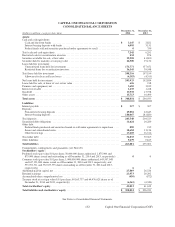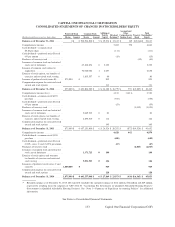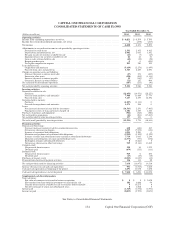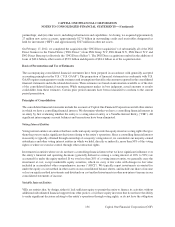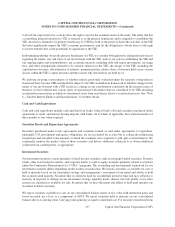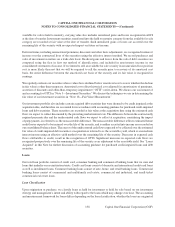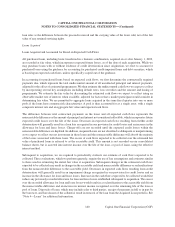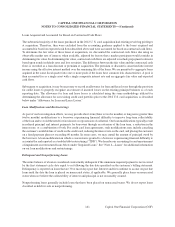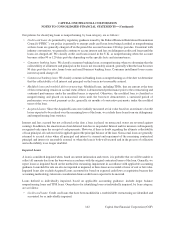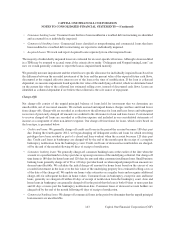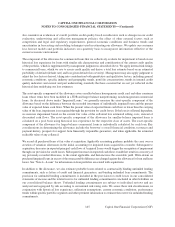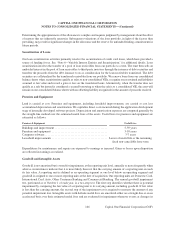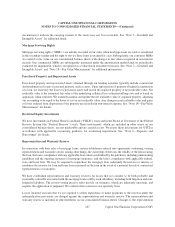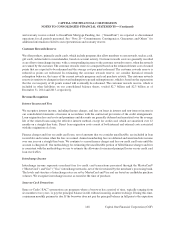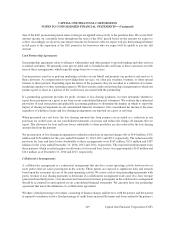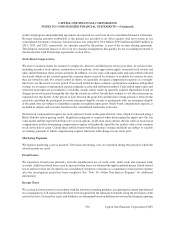Capital One 2014 Annual Report Download - page 163
Download and view the complete annual report
Please find page 163 of the 2014 Capital One annual report below. You can navigate through the pages in the report by either clicking on the pages listed below, or by using the keyword search tool below to find specific information within the annual report.141
Loans Acquired and Accounted for Based on Contractual Cash Flows
The substantial majority of the loans purchased in the 2012 U. S. card acquisition had existing revolving privileges
at acquisition. Therefore, they were excluded from the accounting guidance applied to the loans acquired and
accounted for based on expected cash flows described above and were accounted for based on contractual cash flows.
To determine the fair value of these loans at acquisition, we discounted the contractual cash flows due using an
observable market rate of interest, when available, adjusted for factors that a market participant would consider in
determining fair value. In determining fair value, contractual cash flows are adjusted to include prepayment estimates
based upon trends in default rates and loss severities. The difference between the fair value and the contractual cash
flows is recorded as a loan discount or premium at acquisition. The premium or discount is amortized into interest
income using the effective interest method over the remaining life of the loans. We are permitted to aggregate loans
acquired in the same fiscal quarter into one or more pools if the loans have common risk characteristics. A pool is
then accounted for as a single asset with a single composite interest rate and an aggregate fair value and expected
cash flows.
Subsequent to acquisition, it may be necessary to record an allowance for loan and lease losses through the provision
for credit losses to properly recognize an estimate of incurred losses on the existing principal balances as of each
reporting date. The allowance for loan and lease losses is calculated using the same methodology utilized for
determining the allowance for our existing credit card portfolio prior to the 2012 U.S. card acquisition, as described
below under “Allowance for Loan and Lease Losses.”
Loan Modifications and Restructurings
As part of our loss mitigation efforts, we may provide short-term (three to twelve months) or long-term (greater than
twelve months) modifications to a borrower experiencing financial difficulty to improve long-term collectability
of the loan and to avoid the need for foreclosure or repossession of collateral. Our loan modifications typically result
in reduced principal and interest payments for borrowers through an extension of the loan term, a reduction in the
interest rate, or a combination of both. For credit card loan agreements, such modifications may include canceling
the customer’s available line of credit on the credit card, reducing the interest rate on the card, and placing the customer
on a fixed payment plan not exceeding 60 months. In some cases, we may curtail the amount of principal owed by
the borrower. A loan modification in which a concession is granted to a borrower experiencing financial difficulty is
accounted for and reported as a troubled debt restructuring (“TDR”). We describe our accounting for and measurement
of impairment on restructured loans below under “Impaired Loans.” See “Note 4—Loans” for additional information
on our loan modifications and restructurings.
Delinquent and Nonperforming Loans
The entire balance of a loan is considered contractually delinquent if the minimum required payment is not received
by the first statement cycle date equal to or following the due date specified on the customer’s billing statement.
Delinquency is reported on loans that are 30 or more days past due. Interest and fees continue to accrue on past due
loans until the date the loan is placed on nonaccrual status, if applicable. We generally place loans on nonaccrual
status when we believe the collectability of interest and principal is not reasonably assured.
Nonperforming loans generally include loans that have been placed on nonaccrual status. We do not report loans
classified as held for sale as nonperforming.
CAPITAL ONE FINANCIAL CORPORATION
NOTES TO CONSOLIDATED FINANCIAL STATEMENTS—(Continued)
Capital One Financial Corporation (COF)



